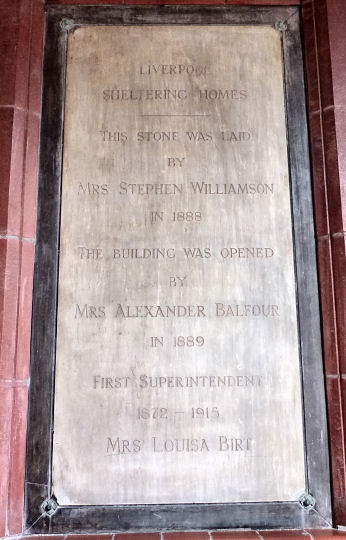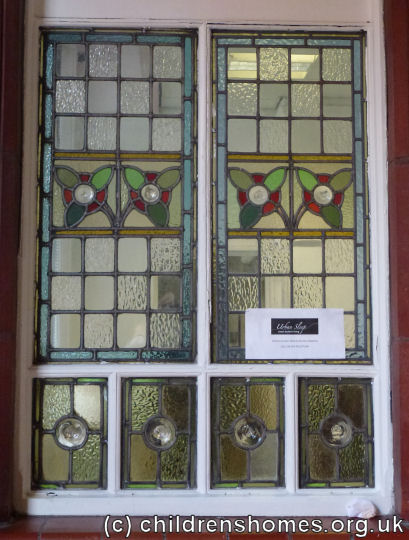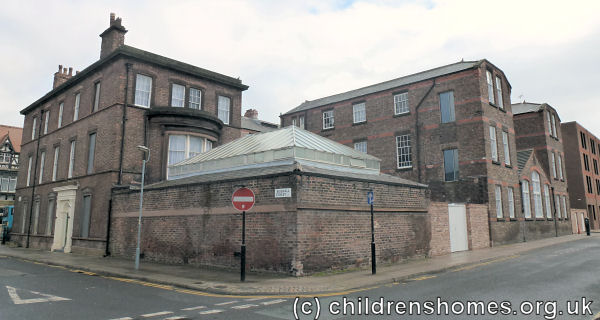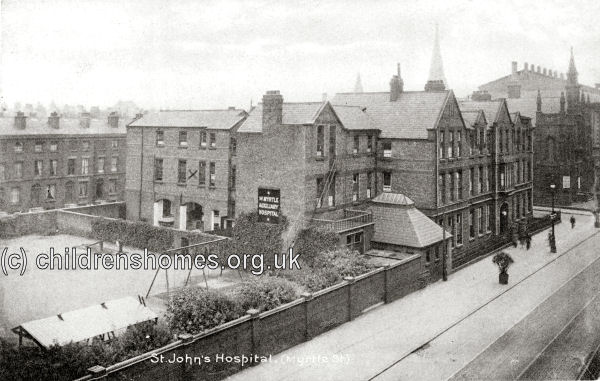Sheltering Home for Destitute Children, Liverpool, Lancashire
Liverpool's Sheltering Home for Destitute Children was inspired by the work of Annie Macpherson, the proprietor of a Home of Industry in East London and promoter of child emigration to Canada. In 1872, increasing concern at the numbers of destitute and orphaned children led Liverpool shipowners Alexander Balfour, Stephen Williamson and John Houghton, to ask Miss Macpherson to give a lecture in Liverpool. Due to Macpherson's commitments in London, her sister and colleague, Mrs Louisa Birt, took up the invitation and in November 1872, at a public meeting in the Law Association Rooms in Cook Street, described their work. The meeting resolved to establish a similar home in Liverpool, with Louisa Birt as its head, and overseen by a committee of fourteen gentlemen with Stephen Williamson as its President. Liverpool MP Samuel Smith also gave his support to the venture. Fund-raising began to finance the establishment which would take in destitute, abandoned or neglected children, with the aim of preparing them for emigration.

Louisa Birt, c.1881. © Peter Higginbotham
The home's first premises, in the former Byrom Hall Baptist Chapel on Byrom Street, were opened on May 1st 1873, with Mrs Birt as resident superintendent. The 1881 census records the home being on the adjacent Circus Street, with Catherine Fox as matron. In 1883, a home for girls was opened at 1 Sugnall Street, initially rented but then purchased along with a neighbouring property on Myrtle Street, in 1888. A large purpose-built home for 120 children was then erected on the site, opening in on November 16th, 1889. An 1894 directory described the premises as being:

Sheltering Home for Destitute Children, Liverpool, c.2012. © Peter Higginbotham

Sheltering Home for Destitute Children, Liverpool, c.2012. © Peter Higginbotham

Sheltering Home for Destitute Children, Liverpool, c.2012. © Peter Higginbotham

Sheltering Home for Destitute Children, Liverpool, c.2012. © Peter Higginbotham

Sheltering Home for Destitute Children, Liverpool, c.2012. © Peter Higginbotham

Sheltering Home for Destitute Children, Liverpool, c.2012. © Peter Higginbotham

Sheltering Home for Destitute Children, Liverpool, c.2012. © Peter Higginbotham
As well as running the Liverpool home, Louisa Birt accompanied parties of children being emigrated to Canada. Initially, a Colonel J.W. Laurie in Nova Scotia assisted with the distribution and supervision of the children, an arrangement which was subsidised by the province's government which was eager to attract settlers. In 1877, following concerns being raised about Laurie's involvement in the scheme, Birt took over the reception home Knowlton, Quebec, which her sister had set up a few years earlier. For the next quarter of a century, two parties of Sheltering Home children were taken to Canada each year.
Louisa Birt remained as superintendent of the home until her death at the age of 74 on 7th May 1915, although she had ceased active work several years before. During her lifetime, around 6,000 children from the home had emigrated to Canada. Following her death, Louisa's daughter Lillian Birt, continued the work although the home was closed during the years of the First World War, when it became St John's Auxiliary Hospital, treating military patients.

St John's Auxiliary Hospital, Liverpool, c.1916. © Peter Higginbotham
When the home resumed in 1919, the Marchmont home in Quebec, established by Annie Macpherson in 1882, became the Sheltering Home's Canadian base.
A number of former Sheltering Home children served in the war as part of the Canadian forces in Europe. Two plaques at the entrance to the building record the names of those who lost their lives during the war.

Sheltering Home for Destitute Children, Liverpool, c.2012. © Peter Higginbotham
An inspection of the home in the early 1900s noted that:
The scheme of the home is to train the children for six months and then take them with the staff of teachers and matrons to Canada where there is a receiving house. There places are found for them. Some return to England either of their own will or as unsuitable. The scheme is said to be very successful. There was complaint that the Guardians did not send Children for the six months. The result was that they could not be sufficiently trained before emigration: There was also complaint that the children were often untaught when they first came — could hardly read for instance; also that the children were sometimes dirty; two cases of itch were mentioned. These children came from London schools. The home is rather bare and rough, but so far as we could judge, it was doing a useful piece of work — worthy of extension.
In 1925, the home was taken over Dr Barnardo's who continued its operation although it now only took boys of working age due to changes in Canadian immigration regulations. With the takeover, Lilian Birt retired but remained involved in an advisory role. The home finally closed in 1935 and was sold to Liverpool Corporation for use as a Juvenile Employment Centre.
The building later housed the F.L. Calder School of Domestic Science. It is now occupied by part of Liverpool's John Moores University.
Records
Note: many repositories impose a closure period of up to 100 years for records identifying individuals. Before travelling a long distance, always check that the records you want to consult will be available.
- Records for the Liverpool Sheltering Homes were inherited by Barnardo's (see below). These include: Registers (1872-1925); Committee minutes (1873-1933); Annual reports (1873-1907); Miscellaneous items (1903-73).
- Barnardo's 'Making Connections' and Family History Services — for enquiries relating the records of children formerly in the care of Barnardo's and those of other organisations absorbed by them.
- Library and Archives Canda, 395 Wellington Street, Ottawa, Ontario. Holdings: Correspondence to and from Louisa Birt and the staff of the Liverpool Sheltering Home from England and Canada.
Census
Bibliography
- Lowe, Clara M.S God's Answers: A Record of Miss Annie Macpherson's Work at the Home of Industry, Spitalfields, London, and in Canada (1882, James Nisbet)
- Bagnell, Kenneth The Little Immigrants: The Orphans Who Came to Canada (2001, Dundurn)
- Birt, Lilian M The Children's Home-Finder: the story of Annie Macpherson and Louisa Birt (1913, J. Nisbet)
- Corbett, Gail H Nation Builders: Barnardo Children in Canada (2002, Dundurn)
- Higginbotham, Peter Children's Homes: A History of Institutional Care for Britain's Young (2017, Pen & Sword)
- Kershaw, Roger and Sacks, Janet New Lives for Old: The Story of Britain's child migrants: The Story of Britain's Home Children (2008, The National Archives)
- Kohli, Marjorie The Golden Bridge: Young Immigrants to Canada 1833-1939 (2003, Natural Heritage Books)
- McEvoy, Frederick J 'These Treasures of the Church of God': Catholic Child Immigration to Canada (in CCHA, Historical Studies, 65 (1999), 50-70)
- Parker, Roy Uprooted: The Shipment of Poor Children to Canada, 1867-1917 (2010, Policy Press)
- Barnardo, Syrie Louise, and Marchant, James Memoirs of the Late Dr Barnardo (Hodder & Stoughton, 1907)
- Batt, J.H. Dr. Barnardo: The Foster-Father of "Nobody's Children" (S.W. Partridge, 1904)
- Bready, J. Wesley Doctor Barnardo (Allen & Unwin, 1930)
- Higginbotham, Peter Children's Homes: A History of Institutional Care for Britain's Young (2017, Pen & Sword)
- Rose, June For the Sake of the Children: Inside Dr. Barnardo's: 120 years of caring for children (Hodder & Stoughton, 1987)
- Wagner, Gillian Barnardo (Weidenfeld & Nicholson, 1979)
Links
- The Barnardo's website.
- British Home Children in Canada.
- Home Children Canada — British Home Children Registry.
- British Home Child Group International — has database of over 23,000 Canadian British Home Children
- National Library and Archives Canada especial the Home Children section.
- British Isles Family History Society of Greater Ottawa (BIFHSGO) — has several indexes of the names of children brought to Canada by various organizations in the 19th and early 20th centuries.
- FindMyPast — Home Children Canada Immigration Records Index, 1869-1930.
- Young Immigrants to Canada. [Archived]
- National Archives of Australia — Immigration Records.
- Good British Stock — Australian National Archives research guide.
- Personal History Index for former Child Migrants to Catholic homes in Australia.
Except where indicated, this page () © Peter Higginbotham. Contents may not be reproduced without permission.


